[ANSWERED] Can Sexual Harassment Happen Outside of Work?
Sexual harassment is apparent in both of these scenarios, but are they punishable because they technically happened outside of the workplace? Let’s take a dive deep into that main question so that we can be more aware of sexual harassment outside of the practical workplace setting.

The short answer to this question is yes, sexual harassment can and does occur outside of work. Sexual harassment is not confined to a work premise or company hours. While this may seem straightforward, it’s important to be aware of sexual harassment both in and out of the practical work place setting.
Did you know? Employers have a responsibility to protect employees from sexual harassment outside of work when it involves employees, vendors, customers, or clients.
SHRM’s sample Sexual Harassment Out Of Work Policy states that employees cannot harass others both on and off the employer premises and during or outside of work hours.
“Title VII of the Civil Rights Act prohibits sexual harassment of any form from occurring in the workplace.”
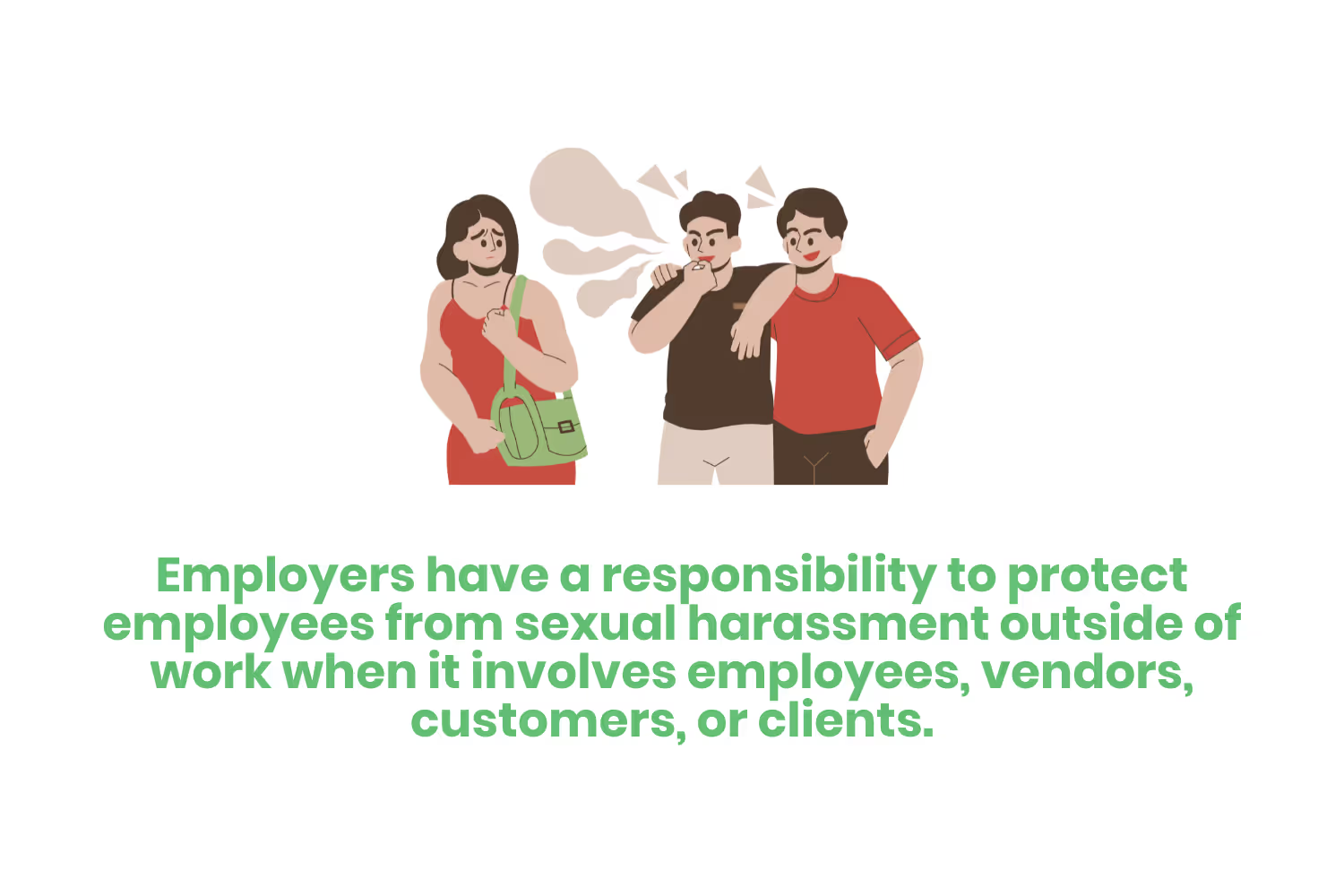
These statements make us aware that sexual harassment in the workplace is not tolerated. But, in certain situations, sometimes the answer isn’t always crystal clear whether or not sexual harassment occurred.
What if you’re attending a company dinner party at a restaurant and there’s a coworker who had a little too much to drink and makes continuous sexual comments toward you? What if you are working at a doctor’s office and there is a patient that gropes you inappropriately without consent?
Sexual harassment is apparent in both of these scenarios, but are they punishable because they technically happened outside of the workplace?
Let’s take a dive deep into that main question so that we can be more aware of sexual harassment outside of the practical workplace setting.
What is Sexual Harassment?
First, let’s define what sexual harassment is. Sexual harassment is harassment based on a person’s sex, gender, race, or ethnicity. It can include any sexual advances, requests for sexual favors, and other verbal or physical harassment such as insults or remarks. In other words, it doesn’t HAVE to be sexual in nature.
Some examples of sexual harassment include but are not limited to:
- Leering
- Unwanted touching
- Sending suggestive notes or emails
- Teasing
- Intimidating or offensive comments based on stereotypes
Unfortunately, an employee’s gender plays a huge role in their chances of experiencing sexual harassment.
- Women: 38% of women admit experiencing sexual harassment in the workplace.
- Men: Nearly 14% of men experience sexual harassment at work.
There are two main categories of sexual harassment that occur in a workplace setting: Quid Pro Quo and Hostile Work Environment.
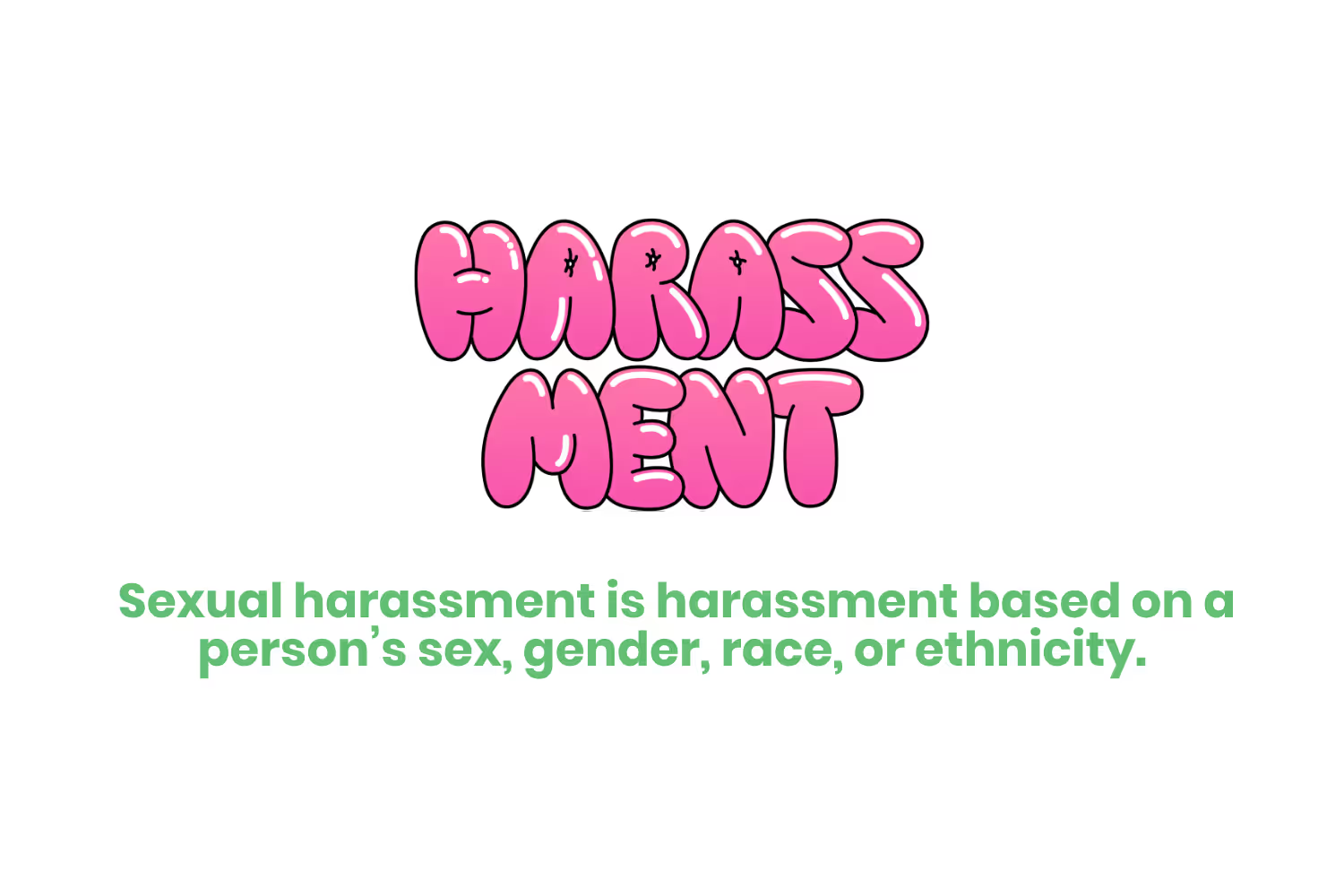
Quid Pro Quo
The literal meaning of quid pro quo is “something for something” or “this for that”.
Quid pro quo occurs when someone forces an employes, usually in a higher-management position, to perform sexual favors or acts in exchange for some type of professional gain.
Examples of “professional gain” include…
- Promotions
- Pay increases
- Preferred assignments
- Punishments such as a demotion or firing
Hostile Work Environment
The first word I think of to describe a hostile work environment is “toxic”.
A hostile work environment exists when an employee feels uncomfortable, scared, intimidated (or all of the above) due to unwelcome conduct.
Outside of Work Events
Sexual harassment isn’t confined to work premises or work hours.
Employees can file sexual harassment outside of working hours as long as there’s a job connection.
To prove that last statement, let’s look at and break down a real case that happened.
The New Hampshire case of McGuinn-Rowe v. Foster’s Daily Democrat is a real case where an employee experienced sexual harassment outside of the workplace and work hours.
In 1990, Mari-Beth McGuinn-Rowe went to grab drinks with some of her coworkers at a nearby bar after work. While at the event, her management-level coworker leaned in and rubbed himself against her. He did this after she had already expressed disinterest in his sexual remarks toward her in the past.
In reporting the incident to her employer, Foster’s Family Democrat, they believed that this fell outside of the scope of their responsibilities because the instance occurred outside of work. The event also happened outside of work hours.

The court sided with McGuinn-Rowe because the incident at the bar created a hostile work environment. McGuinn-Rowe also shared that the accused and another coworker routinely called her pet names and made sexually-charged comments to her in the workplace as well.
The court shared that the employer was liable for the harassment if it knew or should have known about the harrassment’s occurrence and failed to take appropriate steps to stop it, regardless of whether the harassment occurred on or off the work premises.
It’s as important for employers to take action against sexual harassment outside of the workplace as it is on the work premise or during work hours. Just because an employee is off the clock doesn’t mean that they’re free to do as they please if it is harming someone else, especially a co-worker.
Each state has different laws pertaining to sexual harassment. However, the main point of this blog post crosses state lines. Employer’s are responsible for sexual harassment that occurs both inside and outside of the work place. The penalties associated with these instances become more significant if an incident goes unreported and no remediation occurs.
Online Harassment
Sexual harassment is constant and takes on many forms in today’s society. Sometimes it can be hard to recognize sexual harassment in a workplace setting-let alone virtually.
Since COVID-19 many businesses now implement hybrid work environments. While this cuts down physical interactions between employees, we’ve entered an era where you can reach someone from anywhere at any time.
This modern, virtual landscape opens up the door to virtual instances of sexual harassment. In fact, 45% of women report experiencing online harassment.
We now have so much insight into people’s personal lives or what they decide to post on social media. Thus, sexual harassment hasn’t slowed down…it just happens in new, virtual ways.
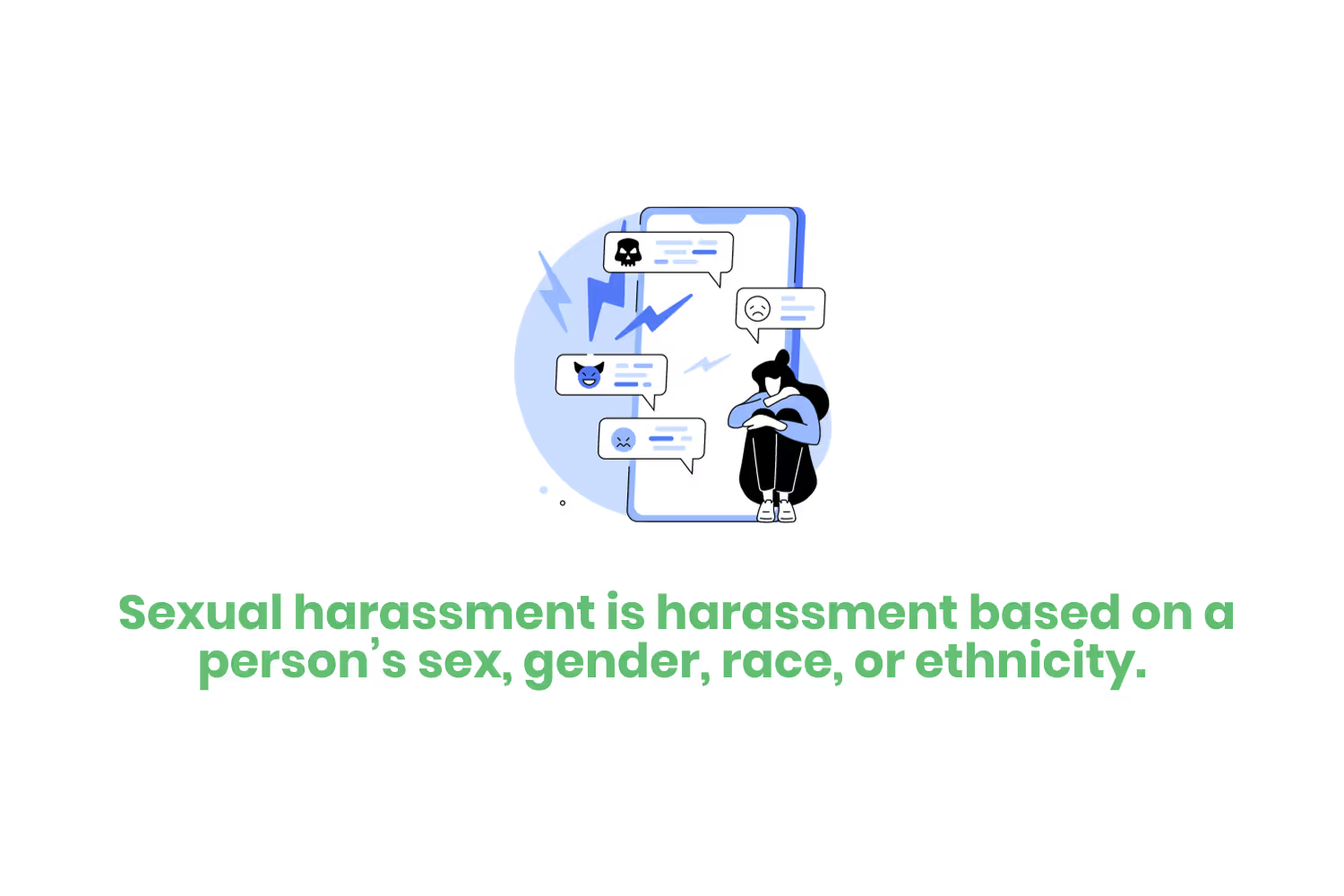
The social capabilities of the web makes it one of the most prevalent places for sexual harassment concerning work. It encompasses a wide range of behaviors that use digital content such as…
- Images
- Videos
- Posts
- Messages
- Webpages and forums
Virtual sexual harassment can look like (via Lavi & Ebrahimian, LLP):
- Inappropriate messages sent via computer, email, cell phone or instant messaging, including sexually suggestive emojis
- Sharing sexually explicit photos or images
- Using gender-based, suggestive or derogatory terms when referring to the victim
- Online stalking, often referred to “cyber-stalking”
- Scheduling, and in some cases demanding, the use of video calls during abnormal work hours
- Violations of the company dress code during video call
Non-Employee Sexual Harassment
Sexual harassment can occur between an employee and a non-employee. Non-employee sexual harassment occurs when a customer, vendor, client, or anyone that doesn’t work for your company makes unwanted sexual advances, comments, or contact with you.
An employee should report these scenarios to their employee if they occur in connection with a job. After all, an employer’s job is to ensure that employees are safe from all sexual harassment pertaining to work which includes from a non-employer . Not doing so leads to liability issues.
If you become a victim of non-employee sexual harassment there are a few key steps you need to take. First, make your employer aware of the unwelcome conduct. Second, gather as much information as possible to prove what took place. This could be a witness, a video recording, an image, or any type of documentation.
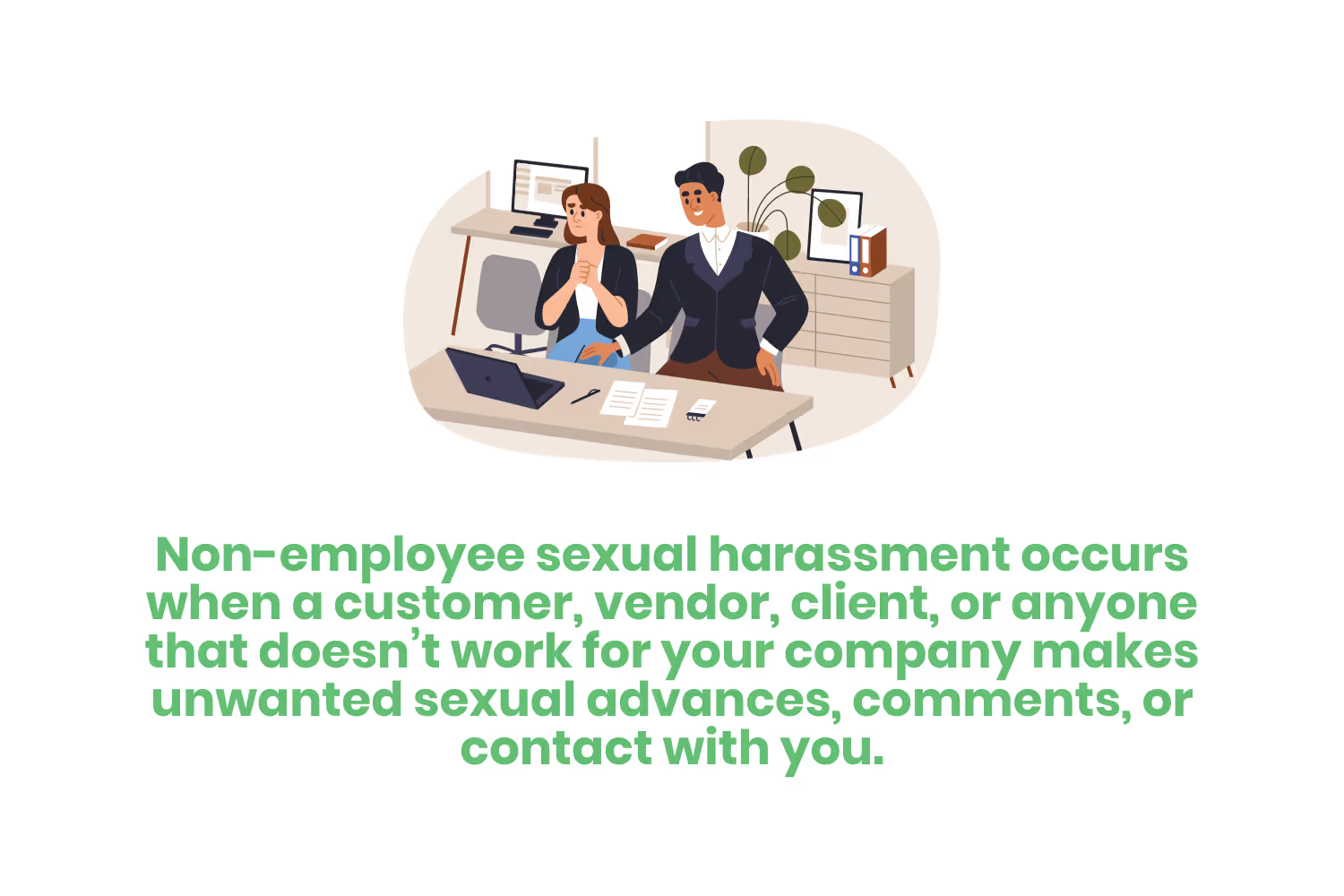
After reporting the incident to your employer, they should initiate a series of remediation steps. First, they should ensure that the harassing individual isn’t allowed to work near or around the victim. Second, directly addressing the harasser. Third, notify any additional third-parties like the harasser’s employer if they’re a non-employee.
We’ve learned so far that employers have a responsibility to ensure that employees are safe from sexual harassment pertaining to the workplace whether it be…
- Off of work premises
- Outside of work hours
- Any type of virtual engagement
But, an employer’s responsibilities to protect their employees don’t end there. No matter where you work or what you do, there are times when you’re interacting with people outside of your company.
These people could be customers, vendors, contractors, or clients. For the sake of this blog, we’ll refer to these people as non-employees or third parties.
Let’s go through some common sexual harassment scenarios between different types of non-employees. We will go through one hypothetical scenario and two real cases where courts pleaded with the plaintiffs that became victims of sexual harassment in the workplace.
Vendor to Employee Scenario
Imagine that you’re working for an access control company as a project manager. One day your supervisor asks you to order security cameras for a client who needs them.
You make a call to your company’s vendor that manufactures security cameras. When the vendor answers the phone, you begin to express your need to order security cameras. The vendor on the phone begins to make flirty comments about your voice and says that they would love to see what you look like in person.
You keep shutting down the compliments and ask to keep this conversation professional, but they keep persisting which makes you uncomfortable. This is sexual harassment. And you should file a report with your supervisor on what happened.
Client to Employee Scenario
Aja M. Crist was an employee of a residential care facility for patients with developmental disabilities. Crist was a care provider and experienced forms of sexual harassment frequently by one patient when she did her rounds. The patient was a 16 year male old who functioned at the level of a 2 to 5 year old child. He was 6 feet tall and weighed over 200 pounds.
Crist notified her supervisor but no immediate remediation action took place. Crist shared an incident where the patient pushed her up against the door by the patient. He tried to remove her clothes to reveal private areas and touched her inappropriately while also pressing himself up against her stomach.
His aggressive behavior continued over time to the point where there was another incident. This time the patient knocked Crist unconscious. Multiple other care providers reported that they experienced sexual harassment by the patient as well.
All of these events led to court. The court pleaded that the employer was responsible for providing a safe work environment and failed to do so. Although the employer cannot guarantee a sexual harassment free workplace, it can take action to end it once made aware.
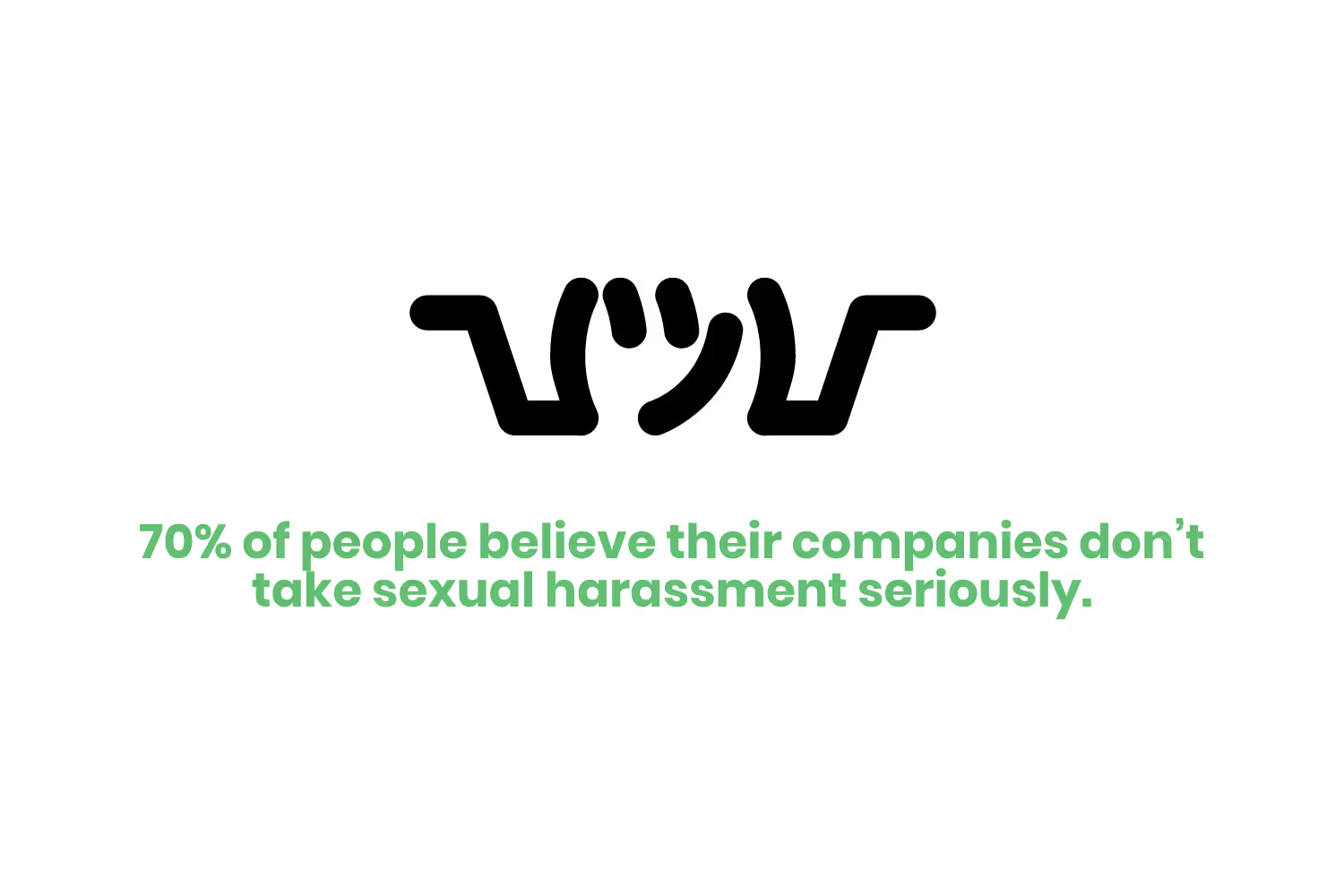
Customer to Employee Scenario
Rena Lockard was a waitress at a chain Pizza Hut Restaurant in Atoka, Oklahoma. Two men that were regulars would come in and Lockard would routinely wait on them. One of the men would continuously play a song on the jukebox with sexually explicit lyrics.
Ms. Lockard told her supervisor, Micky Jack, that she didn’t like waiting on these men. One evening the customers came back in and the wait staff argued over who was responsible for waiting on them. Mr. Jack instructed Ms. Lockard to wait on the men.
When Ms. Lockard approached the table, the men complimented her on her perfume and asked what she was wearing. Ms. Lockard replied that it was none of their business which resulted in one of the men pulling her hair.
Ms. Lockard told Mr. Jack about the incident and that she didn’t want to wait on them any longer. Mr. Jack responded, “You wait on them. You were hired to be a waitress. You waitress.” Ms. Lockard returned to the table with a pitcher of beer. When she reached over to put the pitcher down, one of the men pulled her closer to him by her hair, grabbed her breast, and then put his mouth on her breast.
Naturally, these incidents led to a court case. The court’s response was, ‘‘An employer who condones or tolerates the creation of such an environment should be held liable.’’
The court sided with Ms. Lockard because the restaurant took no action to protect her despite her reports of increasingly abusive behavior by some of the customers.
All of these scenarios show that even if a non-employee inflicts the sexual harassment and creates a hostile work environment it’s the employer’s responsibility to take appropriate actions.
What to Do
Company training is essential to promote awareness about sexual harassment.
As it stands today, 70% of people believe their companies don’t take sexual harassment seriously. It’s important to make sure that people are aware and knowledgeable of sexual harassment as well as the steps to take in the event that sexual harassment occurs.
Training can also help create clear boundaries for employees that don’t have malicious intent but may come off as a little too friendly. It’s important to be aware.
If you feel that someone has taken a conversation too far or has inappropriately stepped out of line, don’t just shake it off. It may be uncomfortable to address or bring up but it is even more uncomfortable long term to keep allowing it.
Speak up. If you see anything suspicious, notify another coworker or your supervisor.
Conclusion
While the question, “Does sexual harassment happen outside of the workplace?” may seem like it has a simple answer, it’s important to bring awareness to this prevalent topic.
Sexual harassment is a common issue in the workplace…but it doesn’t just end there. We must understand that this form of harassment isn’t confined to work premises or work hours. It’s constant and takes on many forms in today’s society, especially virtually.
It’s an ongoing issue that victims can escape once it’s 5 o'clock and the “work day” ends. It’s important for companies to advocate for sexual harassment training. But not just any type of sexual harassment training. It needs to emphasize that if it’s not okay in the workplace then it’s not okay anywhere.
Sexual harassment outside of the workplace can result in creating a hostile work environment. And employees need to feel comfortable and safe knowing that they’re protected on and off the work premises.
Each state has different regulations pertaining to sexual harassment. But, employers have a responsibility to take action for incidents of sexual harassment outside of the workplace. This includes incidents between coworkers and non-employees alike.
Emphasize your product's unique features or benefits to differentiate it from competitors
In nec dictum adipiscing pharetra enim etiam scelerisque dolor purus ipsum egestas cursus vulputate arcu egestas ut eu sed mollis consectetur mattis pharetra curabitur et maecenas in mattis fames consectetur ipsum quis risus mauris aliquam ornare nisl purus at ipsum nulla accumsan consectetur vestibulum suspendisse aliquam condimentum scelerisque lacinia pellentesque vestibulum condimentum turpis ligula pharetra dictum sapien facilisis sapien at sagittis et cursus congue.
- Pharetra curabitur et maecenas in mattis fames consectetur ipsum quis risus.
- Justo urna nisi auctor consequat consectetur dolor lectus blandit.
- Eget egestas volutpat lacinia vestibulum vitae mattis hendrerit.
- Ornare elit odio tellus orci bibendum dictum id sem congue enim amet diam.
Incorporate statistics or specific numbers to highlight the effectiveness or popularity of your offering
Convallis pellentesque ullamcorper sapien sed tristique fermentum proin amet quam tincidunt feugiat vitae neque quisque odio ut pellentesque ac mauris eget lectus. Pretium arcu turpis lacus sapien sit at eu sapien duis magna nunc nibh nam non ut nibh ultrices ultrices elementum egestas enim nisl sed cursus pellentesque sit dignissim enim euismod sit et convallis sed pelis viverra quam at nisl sit pharetra enim nisl nec vestibulum posuere in volutpat sed blandit neque risus.

Use time-sensitive language to encourage immediate action, such as "Limited Time Offer
Feugiat vitae neque quisque odio ut pellentesque ac mauris eget lectus. Pretium arcu turpis lacus sapien sit at eu sapien duis magna nunc nibh nam non ut nibh ultrices ultrices elementum egestas enim nisl sed cursus pellentesque sit dignissim enim euismod sit et convallis sed pelis viverra quam at nisl sit pharetra enim nisl nec vestibulum posuere in volutpat sed blandit neque risus.
- Pharetra curabitur et maecenas in mattis fames consectetur ipsum quis risus.
- Justo urna nisi auctor consequat consectetur dolor lectus blandit.
- Eget egestas volutpat lacinia vestibulum vitae mattis hendrerit.
- Ornare elit odio tellus orci bibendum dictum id sem congue enim amet diam.
Address customer pain points directly by showing how your product solves their problems
Feugiat vitae neque quisque odio ut pellentesque ac mauris eget lectus. Pretium arcu turpis lacus sapien sit at eu sapien duis magna nunc nibh nam non ut nibh ultrices ultrices elementum egestas enim nisl sed cursus pellentesque sit dignissim enim euismod sit et convallis sed pelis viverra quam at nisl sit pharetra enim nisl nec vestibulum posuere in volutpat sed blandit neque risus.
Vel etiam vel amet aenean eget in habitasse nunc duis tellus sem turpis risus aliquam ac volutpat tellus eu faucibus ullamcorper.
Tailor titles to your ideal customer segment using phrases like "Designed for Busy Professionals
Sed pretium id nibh id sit felis vitae volutpat volutpat adipiscing at sodales neque lectus mi phasellus commodo at elit suspendisse ornare faucibus lectus purus viverra in nec aliquet commodo et sed sed nisi tempor mi pellentesque arcu viverra pretium duis enim vulputate dignissim etiam ultrices vitae neque urna proin nibh diam turpis augue lacus.




